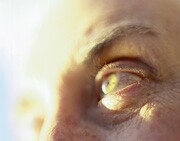
TUESDAY, Oct. 14, 2014 (HealthDay News) — A new study is the first to show the long-term safety of embryonic stem cell transplants to treat human disease.
The research involved 18 people who received the transplants to treat forms of macular degeneration, a leading cause of vision loss.
The transplants, which restored some sight in more than half of the patients, appeared safe up to three years after the procedure.
The study, funded by a U.S.-based company called Advanced Cell Technology, was published Oct. 14 in The Lancet.
“Embryonic stem cells have the potential to become any cell type in the body, but transplantation has been complicated by problems,” lead author Dr. Robert Lanza, chief scientific officer at Advanced Cell Technology, said in a journal news release. Those problems include the rejection of the transplanted cells by the patient’s immune system, as well as the danger that the cells might spur certain types of cancers called teratomas.
A teratoma is a type of cancer that occurs when stem cells develop into multiple types of cells and form incompatible tissues that can include teeth and hair.
As Lanza explained, because of these issues, scientists interested in embryonic stem cell therapy have tended to focused on sites in the body that typically do not produce a strong immune response. The eye is one such spot.
In the new study, human embryonic stem cells were first prompted to develop into eye cells called retinal pigment epithelial cells. They were then transplanted into nine people with Stargardt’s macular dystrophy, and another nine with dry atrophic age-related macular degeneration.
Patient outcomes were tracked for up to three years after transplant. No signs of either cancer-like cell growth (hyperproliferation) or immune system rejection were found in any of the treated eyes after a median follow-up of 22 months, and the only adverse events were linked not to the transplanted cells, but to the eye surgery or immune system suppression needed for the transplant.
Overall, 10 of the 18 patients said they had significant improvements in their vision, and this improvement was only seen in the eyes that had received the stem cell treatment.
“Our results suggest the safety and promise of [human embryonic stem cells] to alter progressive vision loss in people with degenerative diseases and mark an exciting step towards using [these] stem cells as a safe source of cells for the treatment of various medical disorders requiring tissue repair or replacement,” study co-lead author Dr. Steven Schwartz, of the Jules Stein Eye Institute in Los Angeles, said in the news release.
The study is a “major accomplishment,” Dr. Anthony Atala, director of the Wake Forest Institute for Regenerative Medicine, Wake Forest School of Medicine, added in an accompanying commentary.
He said that much research “remains to be done but the path is now set in motion.”
Two other experts were also cautiously optimistic.
“Vision loss from damage to the retina, whether from macular degeneration or diabetes, is irreversible with currently available treatment options,” noted Dr. C. Michael Samson, co-director of Ocular Immunology and Uveitus Service at The New York Eye and Ear Infirmary of Mount Sinai, New York City.
“Stem cell technology offers such patients the best hope in recovering lost vision,” he said. “This pilot study suggests that progress is being made in making stem cell technology to recover vision a reality.”
While Samson agreed that much more research into this technique is needed, “the fact that studies are being done on patients means we are starting what is hopefully the final stage of learning how to reverse vision loss in patients with retinal disease.”
Dr. Mark Fromer is an ophthalmologist at Lenox Hill Hospital in New York City. He said that “this early study offers great promise in the successful utilization of stem cells for the treatment of degenerative diseases in the future.”
More information
There’s more on macular degeneration at the U.S. National Eye Institute.
Copyright © 2025 HealthDay. All rights reserved.

